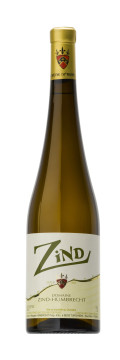
Technical presentation
| Bottling : | February 2016 |
|---|---|
| Acquired alcohol : | 12.4° |
| Residual sugar : | 3.7 g/l |
| Total acidity : | 4.2 g/l H2SO4 (6.4 g/l Acide Tartrique) |
| pH : | 3.1 |
| Yield : | 60 hl/ha |
| Optimum tasting : | 2017-2029+ |
| Average age of vines : | 25 years |
| Terroir : | Clos Windsbuhl |
| Sweetness index : | 1 |
| Soil : | Muschelkalk calcareous |
Description of the wine Zind 2014
The Chardonnay and Auxerrois vines have now reached 25 years old in the Windsbuhl! It definitely shows as these vines are now very consistent and regular. Being slightly earlier ripening and in a cooler micro-climate, they performed very well in 2014. I am often asked to explain this choice of grape variety and the answer is simple: Auxerrois often needs to be blended with another grape that brings structure and acidity and the classic choice is Pinot Blanc. For some reasons, it is difficult to find great massal selections of Pinot Blanc (I’m open to propositions!) and Chardonnay came as natural choice, especially if one consider the old rocky limestone soil of the Windsbuhl. We only planted it in the part of the Clos the nearest to the forest and therefore the coolest, hence the choice of a more precocious grape.

Tasting notes
06/2016 : Light yellow bright colour. The nose shows light mineral/wet rock aromatics. Not yet fully open, but very profound and showing delicate white fruits with time. This is perhaps one of the purest expression of this wine. The palate is elegant, dry, very well structured and showing the classic acidity of the vintage. It is also a wine which is very easy to use at the table.

The Clos Windsbuhl of Hunawihr
The altitude of the vineyard coupled with Hunawihr’s tardy climate means that the Clos Windsbuhl is often one of the last of our vineyards to be harvested. This explains the aromatic quality of the Clos’ wines and the consistent balance of acidity, a guarantee of good ageing. Although often harvested late, the Windsbuhl grapes are only rarely botryitized, doubtless due to the altitude of the vineyard, but nevertheless often reach high levels of maturity.